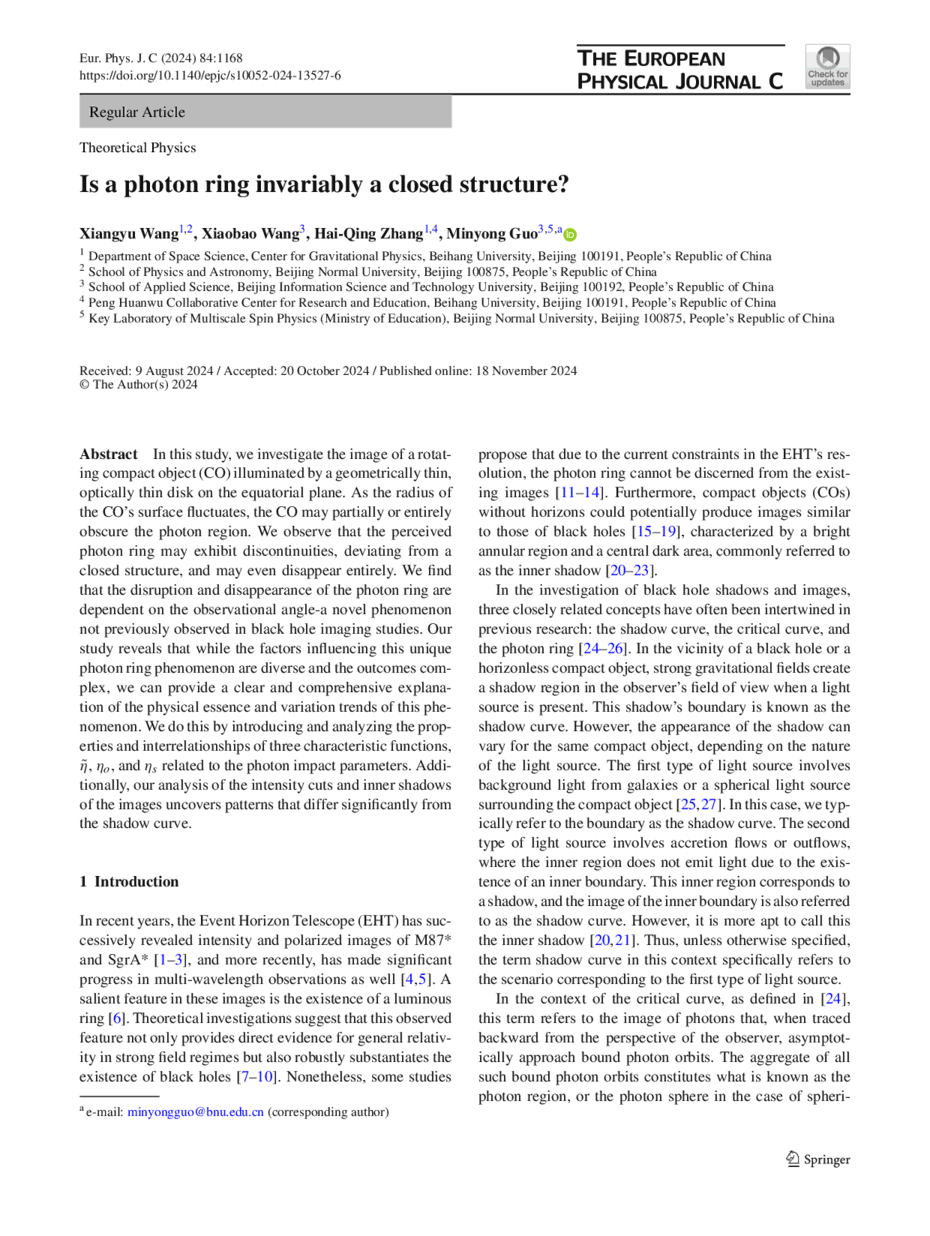https://doi.org/10.1140/epjc/s10052-024-13527-6
Regular Article
Is a photon ring invariably a closed structure?
1
Department of Space Science, Center for Gravitational Physics, Beihang University, 100191, Beijing, People’s Republic of China
2
School of Physics and Astronomy, Beijing Normal University, 100875, Beijing, People’s Republic of China
3
School of Applied Science, Beijing Information Science and Technology University, 100192, Beijing, People’s Republic of China
4
Peng Huanwu Collaborative Center for Research and Education, Beihang University, 100191, Beijing, People’s Republic of China
5
Key Laboratory of Multiscale Spin Physics (Ministry of Education), Beijing Normal University, 100875, Beijing, People’s Republic of China
Received:
9
August
2024
Accepted:
20
October
2024
Published online:
18
November
2024
In this study, we investigate the image of a rotating compact object (CO) illuminated by a geometrically thin, optically thin disk on the equatorial plane. As the radius of the CO’s surface fluctuates, the CO may partially or entirely obscure the photon region. We observe that the perceived photon ring may exhibit discontinuities, deviating from a closed structure, and may even disappear entirely. We find that the disruption and disappearance of the photon ring are dependent on the observational angle-a novel phenomenon not previously observed in black hole imaging studies. Our study reveals that while the factors influencing this unique photon ring phenomenon are diverse and the outcomes complex, we can provide a clear and comprehensive explanation of the physical essence and variation trends of this phenomenon. We do this by introducing and analyzing the properties and interrelationships of three characteristic functions,  ,
,  , and
, and  related to the photon impact parameters. Additionally, our analysis of the intensity cuts and inner shadows of the images uncovers patterns that differ significantly from the shadow curve.
related to the photon impact parameters. Additionally, our analysis of the intensity cuts and inner shadows of the images uncovers patterns that differ significantly from the shadow curve.
© The Author(s) 2024
 Open Access This article is licensed under a Creative Commons Attribution 4.0 International License, which permits use, sharing, adaptation, distribution and reproduction in any medium or format, as long as you give appropriate credit to the original author(s) and the source, provide a link to the Creative Commons licence, and indicate if changes were made. The images or other third party material in this article are included in the article’s Creative Commons licence, unless indicated otherwise in a credit line to the material. If material is not included in the article’s Creative Commons licence and your intended use is not permitted by statutory regulation or exceeds the permitted use, you will need to obtain permission directly from the copyright holder. To view a copy of this licence, visit http://creativecommons.org/licenses/by/4.0/.
Open Access This article is licensed under a Creative Commons Attribution 4.0 International License, which permits use, sharing, adaptation, distribution and reproduction in any medium or format, as long as you give appropriate credit to the original author(s) and the source, provide a link to the Creative Commons licence, and indicate if changes were made. The images or other third party material in this article are included in the article’s Creative Commons licence, unless indicated otherwise in a credit line to the material. If material is not included in the article’s Creative Commons licence and your intended use is not permitted by statutory regulation or exceeds the permitted use, you will need to obtain permission directly from the copyright holder. To view a copy of this licence, visit http://creativecommons.org/licenses/by/4.0/.
Funded by SCOAP3.





